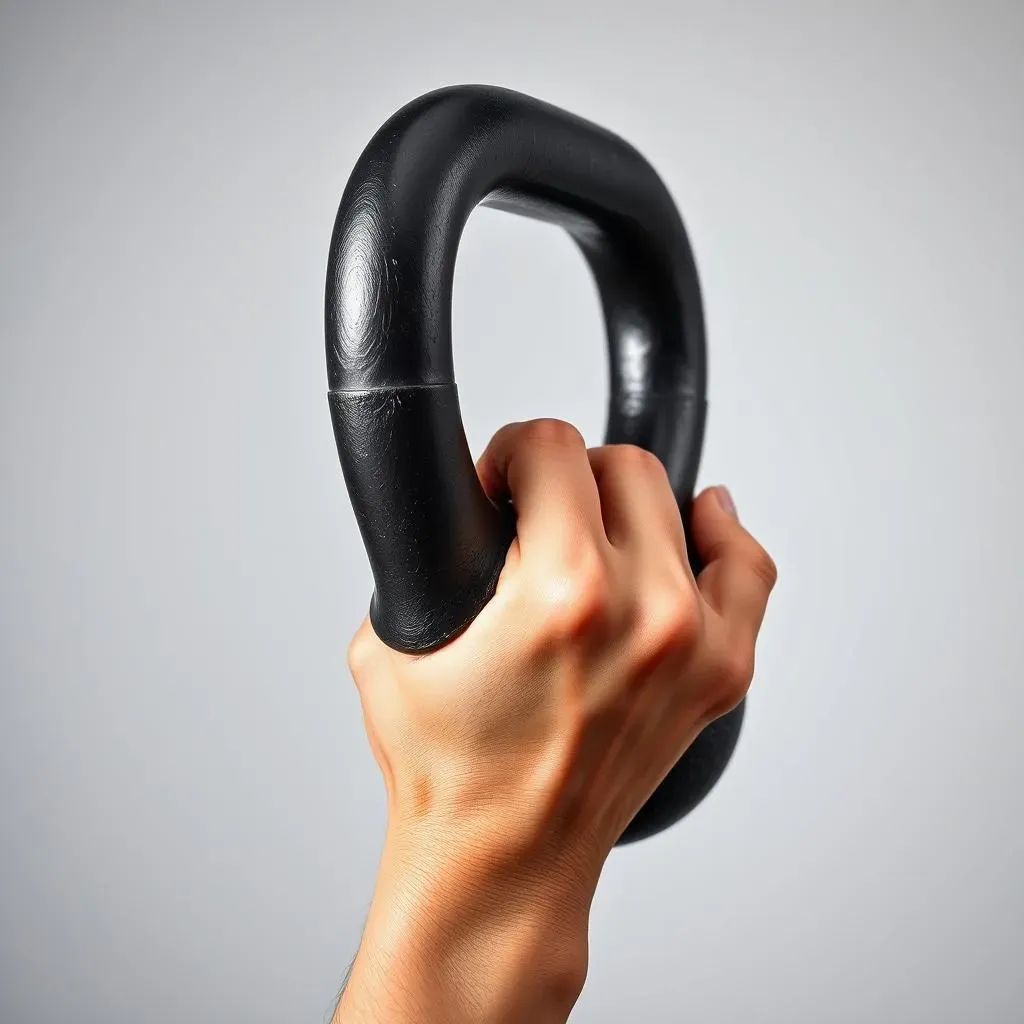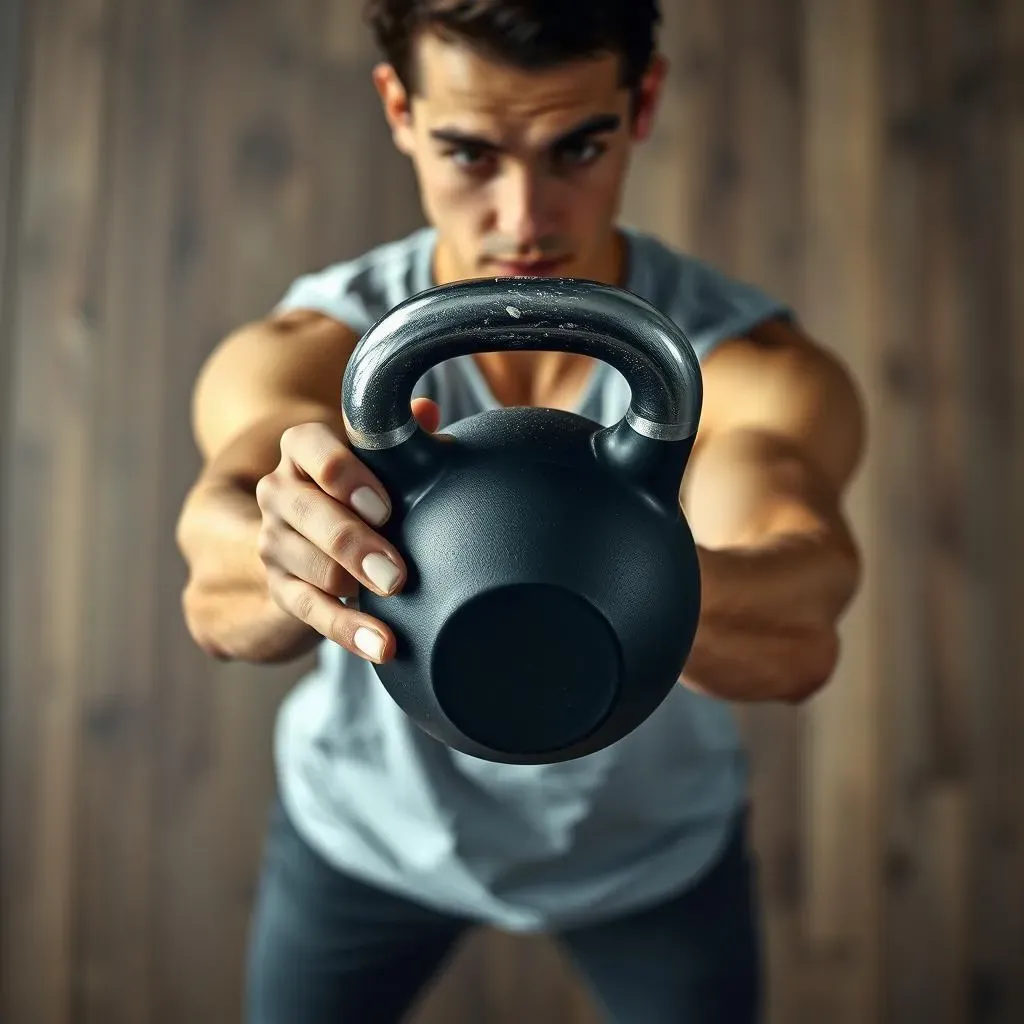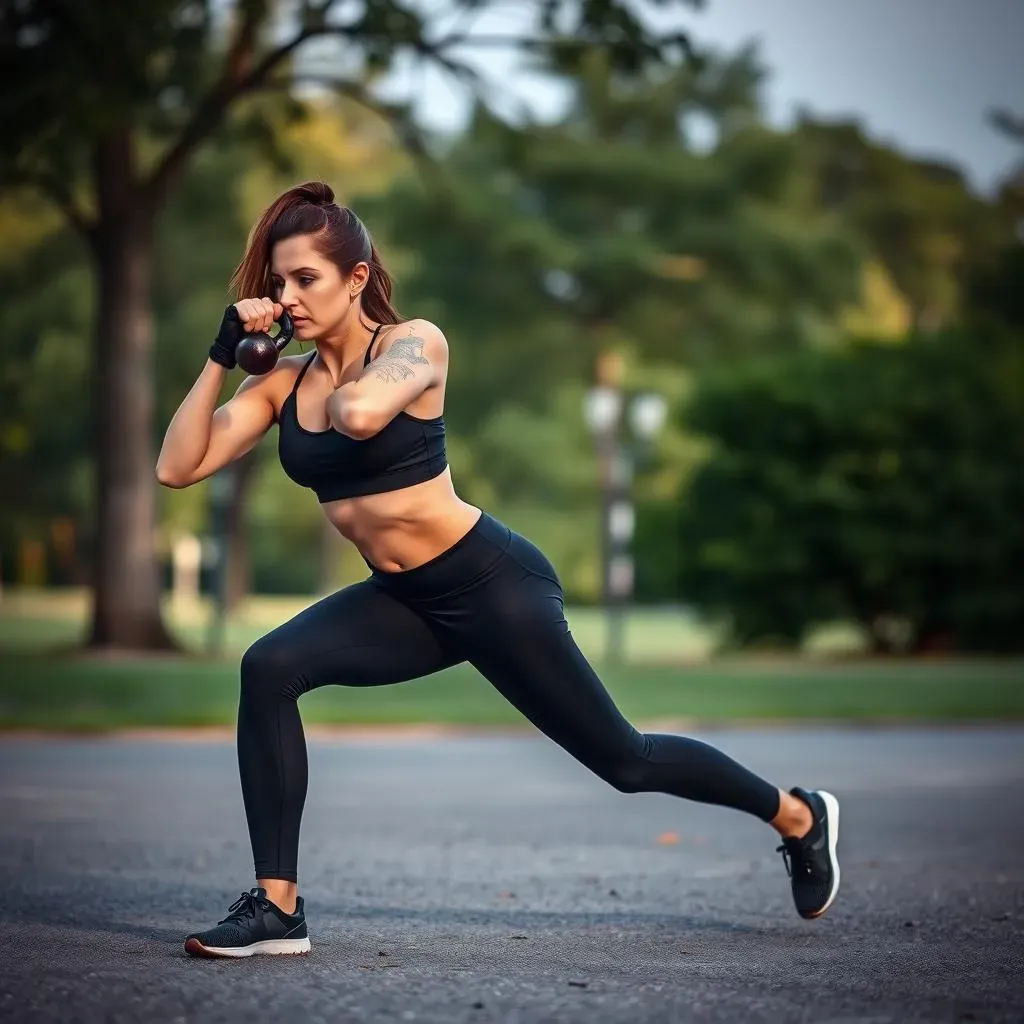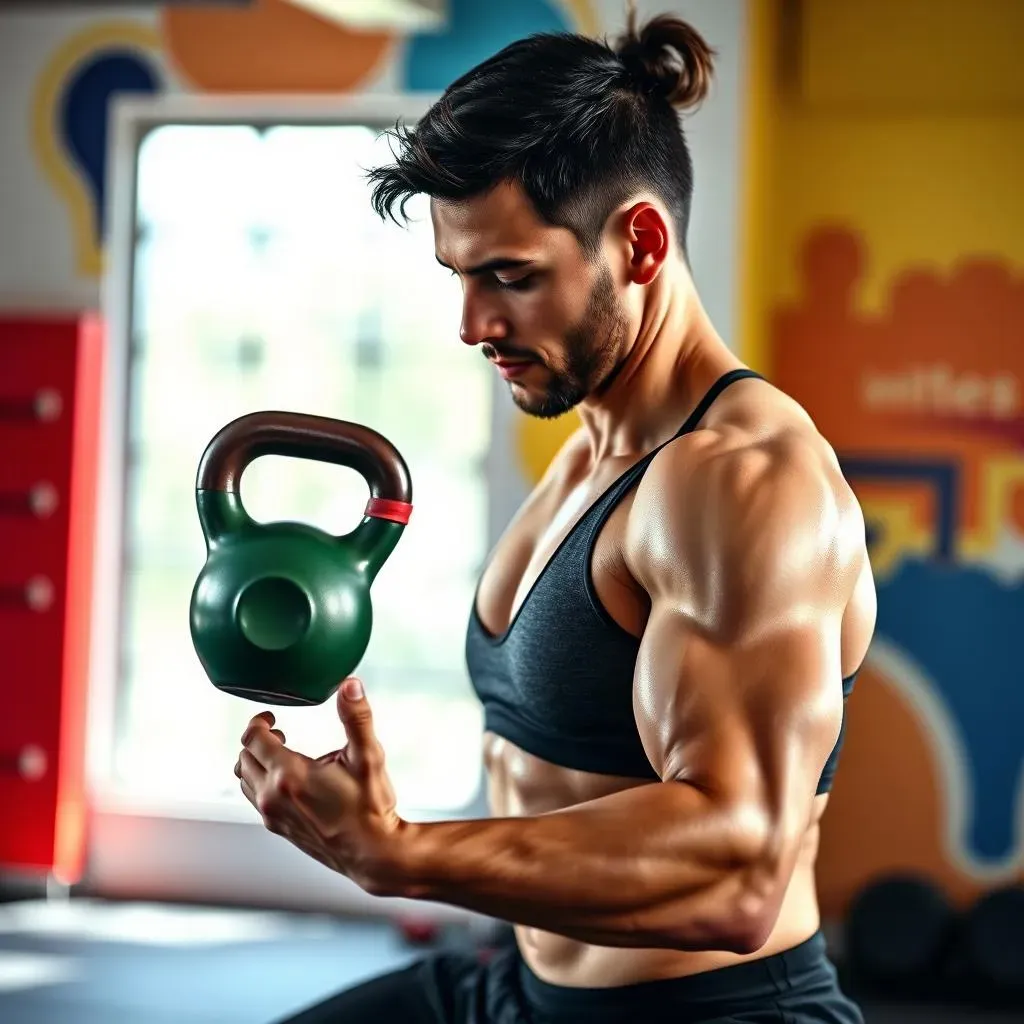Table of Contents
Ever looked at a kettlebell and thought, "That looks intimidating?" I get it. Those cannonball-like weights can seem like they belong in a strongman competition, not in your living room. But guess what? They're actually amazing for beginners, and they're a super fun way to get fit. This article is your guide to an easy kettlebell workout for beginners. We're not talking about crazy acrobatics here, just simple, effective moves that will get your heart pumping and your muscles working. We will cover the basics, like how to hold a kettlebell without looking like you're about to drop it on your foot, and walk you through six essential exercises perfect for starting out. We will also talk about picking the right kettlebell – because lifting a weight that's too heavy is no fun, and picking a light one, might not give the best results. Plus, we’ll look at how you can take your workout to the next level when you’re ready, and if using kettlebells can actually help you lose weight. So, if you're ready to ditch the boring gym routine and try something new, let's grab a kettlebell and get started.
How to Hold a Kettlebell Like a Pro (Even If You're a Beginner)

How to Hold a Kettlebell Like a Pro (Even If You're a Beginner)
The Grip: It's All in Your Hands
Okay, so you've got this iron ball with a handle, now what? First things first, the grip. It's not just about grabbing it any old way. You want a secure hold, like you're shaking hands with the kettlebell, but with a bit more oomph. Think of it as a firm handshake, not a death grip. Your fingers should wrap around the handle, not just your fingertips. You will want to hold it closer to the base of the handle as well, not the top, this will make it way easier to control. The kettlebell should rest in the palm of your hand, not in your fingers. If you are holding it with your finger tips, you’ll get tired quickly and you might lose control of it.
A good grip will help you control the kettlebell. You will want to make sure you are not holding it too tight. When you grip it too hard you will tire your forearms out. You want to be able to swing and move the kettlebell without it slipping out of your hands. This grip is the foundation of all kettlebell exercises, so get it right and you'll be golden. A good grip will help you with every exercise we will be doing, so make sure you get the grip right.
Grip Type | Description | When to Use |
|---|---|---|
Standard Grip | Handle in the palm, fingers wrapped around. | Most exercises: swings, squats, etc. |
Hook Grip | Fingers hooked around the handle. | Heavy lifts, like deadlifts. |
Overhead Grip | Full hand grip, used when pressing over your head. | Overhead presses, snatches. |
The Stance: Feet Firmly Planted
Now that you've got the grip sorted, let's talk about your feet. Imagine you're standing on a solid base; that’s what you want. Your feet should be about shoulder-width apart, maybe a little wider for extra stability. Don't stand like you're on a tightrope. You will want your feet to be firmly planted on the ground. You should be able to move and shift your weight without losing your balance. This will ensure you can move the weight without losing control.
Think of your stance like you're getting ready to jump, you're not stiff and you are ready to move. Your weight should be evenly distributed through your feet. Don't lean too far forward or back. Make sure your core is engaged as well, this will help you maintain your balance. This will not only help you control the kettlebell but also protect your back. A good stance means you’re ready to move the kettlebell with control. Remember that a good stance is just as important as a good grip.
The 6 Best Kettlebell Exercises for an Easy Beginner Workout

The 6 Best Kettlebell Exercises for an Easy Beginner Workout
Kettlebell Halo: Warm-Up Magic
Before we jump into the heavy stuff, let's get those joints moving. The kettlebell halo is like a gentle dance for your shoulders and core. You hold the kettlebell by the horns (the handle), and slowly circle it around your head, keeping it close. It’s not about speed, it's about control and feeling the stretch. Imagine you are tracing a circle around your head with the kettlebell, like a slow-motion halo. This is a great warm-up because it gets your muscles ready, and it's a simple movement anyone can do. It will also help you get a feel for the weight and how it moves.
Keep your core tight, and don't let the kettlebell pull you off balance. You want to make sure you are moving it around your head and not your head around the kettlebell. Do 5 reps in one direction, then switch and do 5 more in the other direction. It’s a small movement, but it makes a big difference in getting you ready to go. It will help you prevent injury and make sure you are ready for the rest of the exercises.
Goblet Squat: The King of All Squats
Now, for the squat. If you ever did a squat without weights, you will see this is very similar, but with a kettlebell. Hold the kettlebell close to your chest, like you're hugging it, and squat down, keeping your back straight. Go as low as you can with good form. It's like you're sitting back into a chair. The kettlebell acts as a counterweight, which can help you keep your balance and go deeper into the squat. It’s not just about getting low, it's about keeping your core engaged and your chest up. This will work your legs and your core, which is a great workout.
This exercise is great for beginners because it teaches you proper squat form and it's easy to scale. If you find this exercise hard, you can do it without the weight until you get the form right. Make sure you are breathing correctly and not holding your breath. You will want to inhale as you go down and exhale as you go up. Do 10-12 reps, focusing on quality over quantity. If you feel any pain, stop and adjust your form. A good squat is a key to many other exercises and this is one of the best ways to learn.
Exercise | Reps | Sets | Focus |
|---|---|---|---|
Kettlebell Halo | 5 each direction | 1-2 | Warm-up, shoulder mobility |
Goblet Squat | 10-12 | 2-3 | Legs, core, posture |
Choosing Your Kettlebell: Weight, Type, and What's Right for You

Choosing Your Kettlebell: Weight, Type, and What's Right for You
Standard vs. Competition: What's the Deal?
Alright, so you're ready to buy a kettlebell, but then you see there are different types. It can be a bit confusing, I know. You've got your standard kettlebells, the ones you probably see at most gyms. These are great for general use. They usually have a wider handle and the weight can vary a bit in size. Then, you've got competition kettlebells. These are all the same size, no matter the weight, and they have a more consistent handle. Competition kettlebells are designed for, well, competition. But, for beginners, a standard kettlebell is perfectly fine, and often more affordable. Don't get bogged down in the details, just pick one that feels good in your hand.
Think of it like buying a pair of shoes. You wouldn't buy a pair of shoes that's too small or too big, right? The same goes for kettlebells. You will want to make sure the handle is comfortable to hold and you have enough space to move around. If you are not sure which one to get, it's always better to start with a standard kettlebell. You can always upgrade later if you get serious about it. The most important thing is that you have a good kettlebell that fits your needs. You do not need to spend too much money, especially when you are starting out.
Finding Your Perfect Weight: Not Too Heavy, Not Too Light
Now, for the million-dollar question: what weight should you start with? This is where people get really confused. The most common mistake I see is people going way too heavy, way too fast. You are not trying to win a weightlifting competition. You want to start with a weight that feels challenging but allows you to maintain good form. For most women, I'd recommend starting with a 10-12kg (20-25 lbs) kettlebell, and for men, a 14-16kg (30-35 lbs) kettlebell. Remember, these are just starting points, and if you're not sure, go lighter. It's better to start too light than too heavy.
Think of it like learning to ride a bike. You wouldn't start on the biggest bike you can find, would you? You'd start with a small bike with training wheels, and then you would upgrade when you get better. The same goes for kettlebells. You want to make sure you are comfortable with the weight you are using. It will help you learn the proper form and prevent injuries. You want to be able to do all the exercises in the previous section without losing form. If you are struggling to maintain the form, you might be using too much weight. Always prioritize good form over lifting heavy. You can always increase the weight later.
Kettlebell Type | Handle | Size | Best for |
|---|---|---|---|
Standard | Wider, can vary | Varies | General use, beginners |
Competition | Consistent, thinner | Same size regardless of weight | Competition, advanced users |
From Beginner to Intermediate: Leveling Up Your Kettlebell Game

From Beginner to Intermediate: Leveling Up Your Kettlebell Game
When to Move On: Are You Ready?
So, you've mastered the basics, you're swinging that kettlebell like a pro, and you're starting to feel like a superhero? Awesome! But how do you know when it's time to move beyond the easy beginner stuff? It's not about rushing; it's about feeling confident and comfortable with the foundational exercises. Can you do all the beginner exercises with good form, without feeling like you're about to collapse? Can you do at least 10-12 reps of each exercise without losing your form? If you are answering yes, then it's a good sign that you are ready to take your workout to the next level.
Listen to your body. If you're starting to feel bored or like the beginner exercises are not challenging you anymore, that's another sign that it’s time to mix things up. Don't just jump into advanced moves right away. Start by adding a few new exercises to your routine, or by increasing the weight a little bit. Remember, the goal is to make progress, not to injure yourself. It's like graduating from kindergarten to first grade, you need to have the basics down before you jump into more complicated things. It's all about gradual progress and listening to your body.
New Moves, New Challenges: Intermediate Exercises
Alright, let's talk about some intermediate exercises that will kick things up a notch. One of my favorites is the kettlebell lateral goblet lunge. It’s like a regular goblet squat, but you step out to the side instead of straight down. This will work your legs in different ways, and improve your balance and stability. Another great exercise is the renegade row. You get into a push-up position while holding the kettlebells, and then you row one kettlebell up towards your chest, and then you repeat on the other side. This will work your core, your back, and your arms all at once. It’s a full-body workout that will make you feel like a beast.
These new exercises will help you challenge your body in new ways, and you’ll start to see results quickly. Don't be scared to experiment and try different exercises. There are so many great kettlebell exercises out there, and you will want to try them all. Just make sure you are doing them with good form. If you are not sure how to do them correctly, you can always watch videos or ask a trainer for help. It's important to learn the proper form before you go heavy. Remember, quality over quantity. It's better to do 5 reps with good form than 20 reps with bad form. Take your time, learn the moves, and have fun with it.
Exercise | Focus | Why it's great |
|---|---|---|
Kettlebell Lateral Goblet Lunge | Legs, balance, stability | Works muscles in different ways, improves balance |
Renegade Row | Core, back, arms | Full-body workout, builds strength |
Progression: Adding Weight, Reps, and Sets
Now that you've got some new exercises in your arsenal, let's talk about how to keep progressing. It's not just about learning new moves; it's also about making your current routine more challenging. This can be done by increasing the weight you're lifting, increasing the number of reps you're doing, or increasing the number of sets. For example, if you are doing 10 reps of goblet squats with a 10 kg kettlebell, you can try to increase it to 12 or 15 reps, or you can try to use a 12kg kettlebell instead. Remember to gradually increase the weight, reps, or sets. Don't try to do too much too soon. You don't want to get burned out or injured.
It’s like leveling up in a video game, you need to gain some experience before you can move on to the next level. You will want to make sure you are progressing at your own pace. Don't compare yourself to others, everyone is different. The most important thing is that you are making progress and you are feeling good about it. If you are not sure how to progress, you can always ask a trainer for help. They can help you create a workout plan that is tailored to your needs. The most important thing is to keep challenging yourself and keep making progress. Your body will thank you for it.
Kettlebells and Weight Loss: Can This Actually Work?

Kettlebells and Weight Loss: Can This Actually Work?
The Truth About Kettlebells and Calories
Okay, let's get real. Can swinging around a hunk of iron actually help you lose weight? The short answer is yes, but it's not magic. Kettlebells are amazing for building muscle, and more muscle means your body burns more calories, even when you're just chilling on the couch. Think of your muscles like little furnaces constantly burning fuel. The more furnaces you have, the more calories you burn, it is that simple. When you combine strength training with kettlebells and a good diet, you create a powerful combination for weight loss. It's not just about burning calories during the workout, it's about creating a more efficient fat-burning machine in your body.
The beauty of kettlebells is that they engage multiple muscle groups at once. Exercises like swings, squats, and lunges work your legs, core, and back, which means you're getting a full-body workout in a short amount of time. This is far more efficient than spending hours on a treadmill. It's not just cardio, it's strength training, which is way more effective for long-term weight management. So, if you're looking for a workout that will burn calories and build muscle at the same time, kettlebells are definitely worth considering. Remember, it is a tool, it is not some kind of magic pill that will make you lose weight overnight.
Benefit | Description |
|---|---|
Increased Calorie Burn | More muscle means more calories burned at rest. |
Full-Body Workout | Engages multiple muscle groups for efficient training. |
Improved Metabolism | Builds muscle, boosting your body's ability to burn fat. |
The Importance of Diet: You Can't Out-Train a Bad Diet
Now, here's the part that many people don't want to hear: you can't out-train a bad diet. You can swing a kettlebell all day long, but if you're eating junk food, you're not going to see the results you want. Weight loss is a combination of exercise and nutrition, and you need to get both of them right. Think of it like a car, you can have the most powerful engine in the world, but if you are using bad fuel, it's not going to perform well. Your body is the same way, you need to make sure you are fueling it with good food.
Focus on eating whole, unprocessed foods like fruits, vegetables, lean proteins, and whole grains. Cut back on sugary drinks, processed snacks, and fast food. It's not about being perfect, it's about making consistent, healthy choices. It's like building a house, you need a solid foundation, and that foundation is your diet. And remember, it is not about starving yourself, it is about eating the right foods. It is about being mindful of what you put into your body. Small changes can make a big difference. So, if you are serious about losing weight with kettlebells, make sure you are also taking care of your diet.